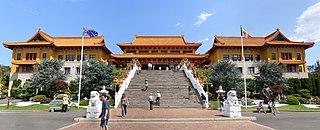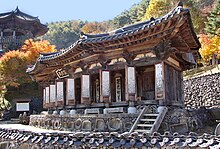
Dangun or Tangun, also known as Dangun Wanggeom, was the legendary founder and god-king of Gojoseon, the first Korean kingdom, around present-day Liaoning province in Northeast China and the northern part of the Korean Peninsula. He is said to be the "grandson of heaven" and "son of a bear", and to have founded the kingdom in 2333 BC. The earliest recorded version of the Dangun legend appears in the 13th-century Samguk Yusa, which cites China's Book of Wei and Korea's lost historical record Gogi. However, it has been confirmed that there is no relevant record in China's Book of Wei. There are around seventeen religious groups that focus on the worship of Dangun.

Korean mythology is the group of myths told by historical and modern Koreans. There are two types: the written, literary mythology in traditional histories, mostly about the founding monarchs of various historical kingdoms, and the much larger and more diverse oral mythology, mostly narratives sung by shamans or priestesses (mansin) in rituals invoking the gods and which are still considered sacred today.

The traditional Korean calendar or Dangun calendar is a lunisolar calendar. Dates are calculated from Korea's meridian, and observances and festivals are based in Korean culture.

Gojoseon, also called Joseon, was the first kingdom on the Korean Peninsula. According to Korean mythology, the kingdom was established by the legendary king Dangun. Gojoseon possessed the most advanced culture in the Korean Peninsula at the time and was an important marker in the progression towards the more centralized states of later periods. The addition of Go, meaning "ancient", is used in historiography to distinguish the kingdom from the Joseon dynasty, founded in 1392 CE.

The Three Pure Ones, also translated as the Three Pure Pellucid Ones, the Three Pristine Ones, the Three Divine Teachers, the Three Clarities, or the Three Purities, are the three highest gods in the Taoist pantheon. They are regarded as pure manifestations of the Tao and the origin of all sentient beings, along with the "lords of the Three Life Principles or 'Breaths' (qi)". They were also gods who were "associated with the sky, the earth and the underworld."

Fo Guang Shan Nan Tien Temple is a Buddhist temple complex located in Berkeley, on the southern outskirts of the Australian city of Wollongong, approximately 80 kilometres (50 mi) south of Sydney.

Haneunim or Hanunim is the sky God of Cheondoism and Jeungsanism. In the more Buddhist-aligned parts of these religions, he is identified with Indra. In the more Taoist-aligned parts of these religions, he is also known as Okhwang Sangje and under that name, he is a deity in the Poncheongyo religion.

Korean gardens are a type of garden described as being natural, informal, simple and unforced, seeking to merge with the natural world. They have a history that goes back more than two thousand years, but are little known in the west. The oldest records date to the Three Kingdoms period when architecture and palace gardens showed a development noted in the Korean History of the Three Kingdoms.
Shin, also spelled Sin, or Sheen, is a Korean surname, a single-syllable Korean given name, and an element in two-syllable Korean given names. As given name meaning differs based on the hanja used to write it. There are 34 hanja with the reading "shin" on the South Korean government's official list of hanja which may be registered for use in given names.
Moy Lin-shin was a Taoist monk, teacher and tai chi instructor who founded The Taoist Tai Chi Society, the Fung Loy Kok Institute of Taoism and the Gei Pang Lok Hup Academy.

Gaecheonjeol is a public holiday in South Korea on 3 October. Also known by the English name National Foundation Day, this holiday celebrates the legendary formation of the first Korean state of Gojoseon in 2333 BC. This date has traditionally been regarded as the date for the founding of the Korean people.

Beopjusa, is a head temple of the Jogye Order of Korean Buddhism. It is situated on the slopes of Songnisan, within Songnisan National Park, in Naesongni-myeon, Boeun County, in the province of Chungcheongbuk-do, South Korea.
Ungnyeo was a bear that became a woman according to the creation myth of the Korean nation.

Daejongism or Dangunism is the name of a number of religious movements within the framework of Korean shamanism, focused on the worship of Dangun. There are around seventeen of these groups, the main one of which was founded in Seoul in 1909 by Na Cheol.

A sotdae is a tall wooden pole or stone pillar with a carved bird on its top, built for the purpose of folk belief in Korea. Like jangseung, wooden totem poles with a sculptured human face, it was usually erected near the entrance of a village to ward off evil spirits as well as to represent villagers' wishes for prosperity and well-being. Later, it was also built as a celebratory or commemorative symbol. For instance, when a son of a family passed a civil service examination called gwageo, a sotdae was set up in the yard. In that case, it was colored in orange and topped with a blue dragon.

The Queen Mother of the West, known by various local names, is a mother goddess in Chinese religion and mythology, also worshipped in neighbouring Asian countries, and attested from ancient times. From her name alone some of her most important characteristics are revealed: she is royal, female, and is associated with the west.

Mountain Gods (山神) are Asian tutelary deities associated with mountains. They are related to landlord deities and tudigongs and City Gods.

Seonam Temple, or Seonamsa, is a Korean Buddhist temple on the eastern slope at the west end of Jogyesan Provincial Park, within the northern Seungjumyeon District of the city of Suncheon, South Jeolla Province, South Korea. It belongs to the Taego Order although the Jogye Order claims possession over it.

Mu (Korean: 무) is the Korean term for a shaman in Korean shamanism. Korean shamans hold rituals called gut for the welfare of the individuals and the society.

Jincheon Gilsangsa is a shrine dedicated to the general Kim Yu-sin (595–673) located in Jincheon-eup, Jincheon County, North Chungcheong Province, South Korea.





























